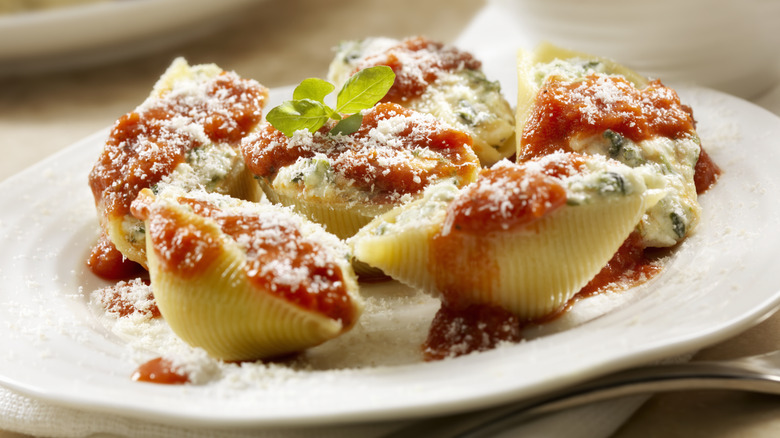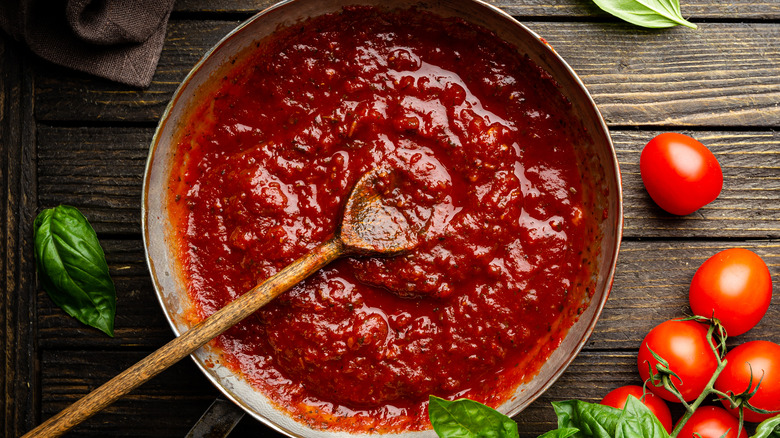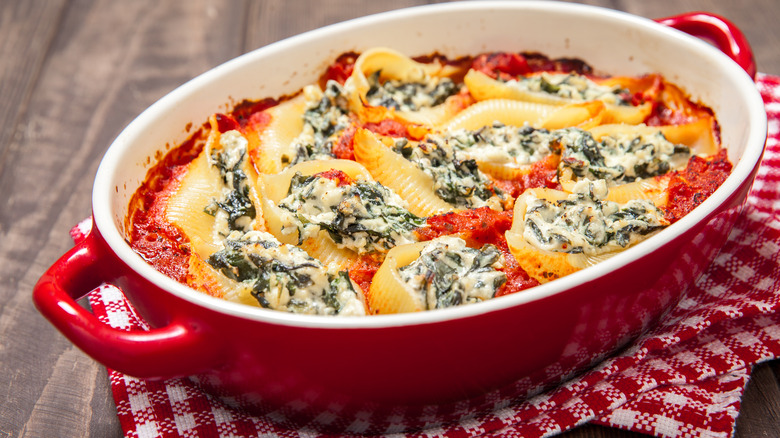The Easy Way To Freeze Stuffed Pasta So They Don't All Stick Together
Whether you're preparing a meal for an upcoming event or simply making dinner for yourself (or your family), stuffed shells are a hearty and wholesome option. While variations abound, most stuffed shells recipes include ricotta cheese, tomato sauce, and of course, jumbo pasta shells to hold all that glorious stuffing. In the event you want to prepare a meal ahead of time, or you want to enjoy your tasty leftovers throughout the course of the next few days, there are certain steps you can take to freeze the shells without compromising quality. Pasta has a tendency to stick together when placed in the freezer, but you can avoid this unwanted outcome with a little preparation.
Simply take a baking sheet and line it with parchment paper, which is excellent for stopping foods from sticking together. Next, take the partially-baked stuffed shells — partially baking the pasta will make it more pliable and easier to fill — and spread them over the parchment paper. Then, place the baking sheet in the freezer just long enough for the pasta to harden. Once the shells firm up, you can then transfer them to a sealable container. Of course, no pasta dinner would be complete without the sauce, but there are different schools of thought when it comes to freezing this essential accompaniment.
Should you freeze shells with sauce?
What if you've already added sauce to your recipe? Can you store both the sauce and pasta at the same time? As Taryn Pire writes for PureWow, "Feel free to freeze them together, ideally in an oven- or microwave-safe dish for easy heating later on."
However, freezing sauce separately is another good option, as it often results in a tastier dish upon reheating. First, determine how much sauce you'll be freezing to ensure the best possible storage method. When it comes to large amounts of red sauce, freezer-safe bags are an excellent option. In this case, make sure the sauce is completely cool before putting it into bags, which you can place on a baking sheet in stacks within the freezer.
You can also use muffin tins to create individual portions of sauce, which can then be placed in bags after they're frozen. Just be sure to grease the interior of the tins to easily remove the sauce when transferring to bags.
When the time comes to cook your tasty meal, the sauce can be thawed in the microwave or in a frying pan on your stove. You can also place the bagged sauce in the refrigerator and allow it to defrost overnight first. As for thawing your pasta, the best method depends on whether it was fully or partially cooked before freezing.
Tips for thawing and cooking frozen stuffed shells
You can conveniently thaw shells overnight in your refrigerator to prepare them for the next day. When you're ready for dinner, preheat your oven to 350 degrees Fahrenheit and put your already-cooked shells in for about 45 minutes. If you only partially cooked the pasta prior to freezing, you'll need to leave them in the oven for 1 hour and 15 minutes to make certain they're evenly cooked throughout.
You can also cook frozen shells without thawing if you're in a hurry or forgot to transfer them into the fridge earlier. If the shells were fully cooked prior to freezing, they should be placed into the oven (set at 350 degrees Fahrenheit) and cooked for up to 1 hour; use a thermometer to ensure the filling achieves a temperature of at least 165 degrees Fahrenheit. In the event the pasta was only partially cooked prior to freezing, the shells need to remain in the oven for about 30 minutes longer. Regardless of which method you use, make sure your sauce completely covers the pasta when it's in the baking dish.


